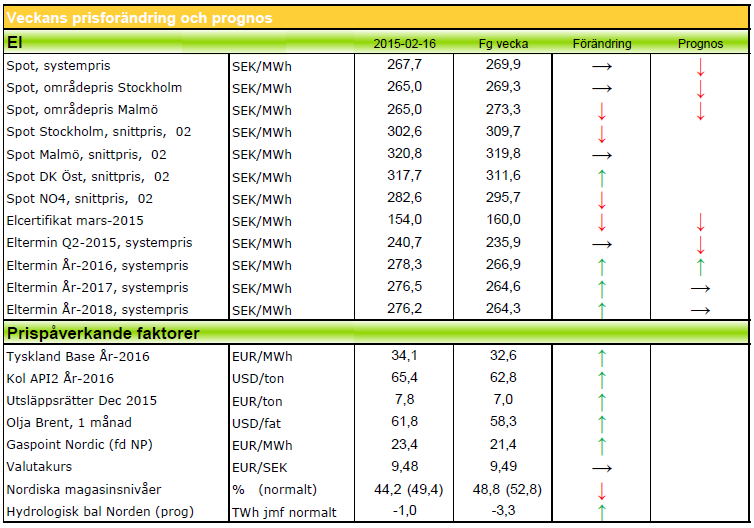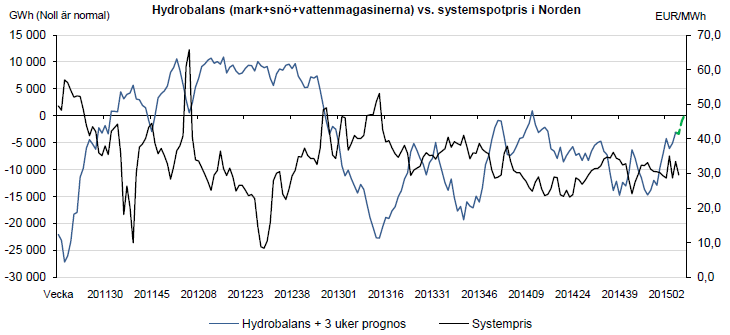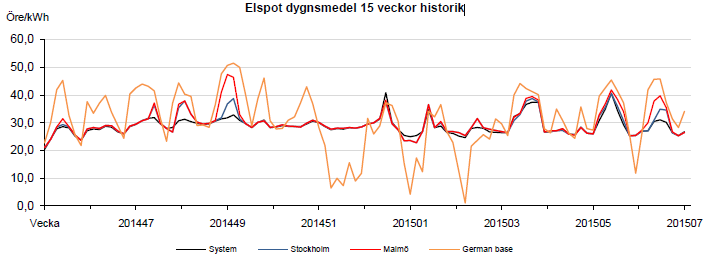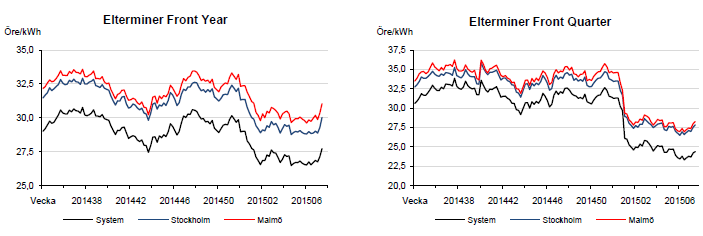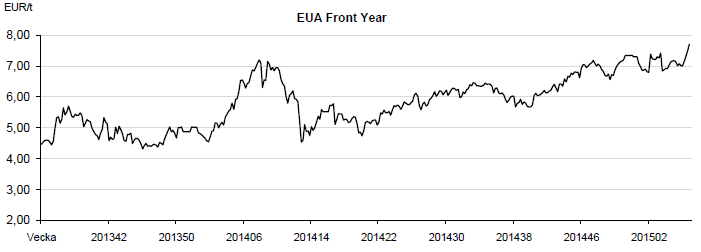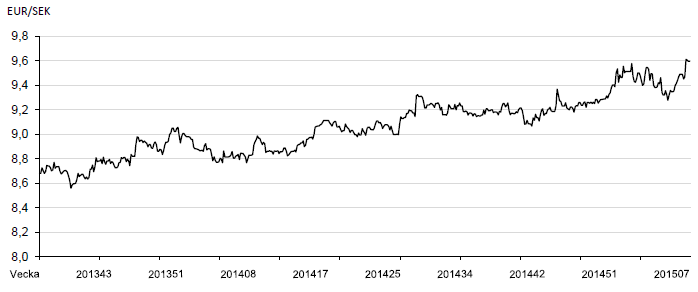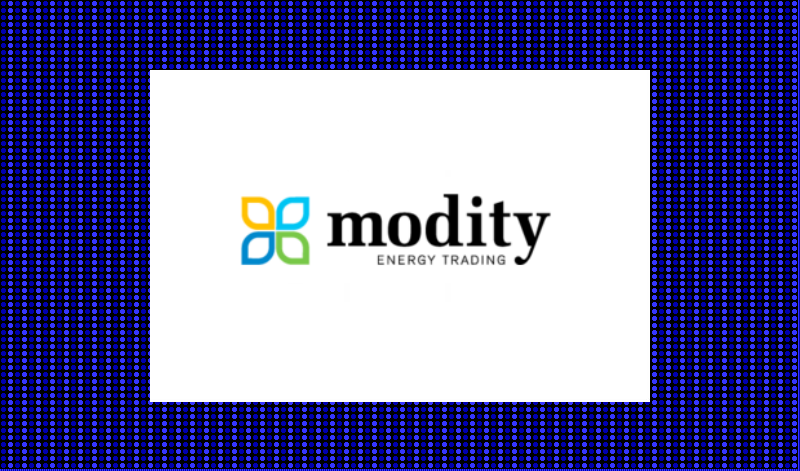Analys
Modity om elpriset vecka 8 2015
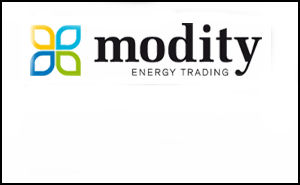
Veckans marknadskommentar
Kol och olja upp och drar med sig de långa elterminerna. Den korta elen är ned på varma, blöta och blåsiga prognoser. Utsläppsrätterna börjar nu stärkas rejält i avvaktan på omröstning. Hydrobalansen är för första gången på länge positiv samt att vi väntar mycket nederbörd den kommande tiodagarsperioden.
Hydrobalansen ligger v06 på 0,7 TWh över normalen. Så mycket nederbörd som det kommit sedan sist! Man pratar om den snörikaste vintern på över 50 år i västra Norge! Det är fortfarande så att prognoserna ser blöta och milda ut så en fortsatt upplagring av energi över normalen verkar det bli!
Kärnkraftverken i Norden har idag den 16/2 en produktion på 73 % (9 031 MW). Ringhals 4 är fortfarande ute för att ordna till läckan. Tillbaka på onsdag. Annars är Oskarshamn 2 kvar ute till september och Ringhals 2 till november. Finska Olkiluoto 2 är fortfarande ur drift – förlängt detta till återstart 18 februari. De finska verken körs därmed 68 %.
Systemspotpriset förra veckan blev 29,61 €/MWh. Det var en tillbakagång på nästan fyra euro. I prisområde SE3 blev den 30,87 och i SE4 33,34. Nu ser vi en ökning i temperaturerna igen och spoten förväntas inte överstiga 30 €/MWh (SYS).
Terminspriser
Förra veckan byttes de överblöta prognoserna ut mot mer måttliga och det fick veckan att visa en uppåtrörelse i både Q2-15 och YR-16. Den senare rätt så kraftigt. Skillnaden terminerna emellan var att Q2:an kom tillbaka lite på fredagen. Det gjorde inte året. Idag har nya prognoser i det närmaste fått Q2 att peka nedåt. Däremot ångar YR-16 på åt andra hållet. Det längre påverkas av andra faktorer än vädret i större grad än det korta. Vi ser högre priser i kol och CO2, vilket ger en starkare långtermin. Q2:an är mycket känsligare för vädret som är just nu och därför drar den nedåt. Omsätts i skrivande stund på 25,10. År 16 handlas nu på 28,90 €/MWh.
Bränslemarknaden
Utsläppsrätter, CO2
Det verkar nu som denna marknad har börjat bli nervös inför omröstningen om en vecka. Räknat från dippen vid förra omröstningen har priset nu stigit från 6,84 €/ton den 22 feb, till 7,83 senast omsatt idag. Lägg därtill att euron stärkts samtidigt så har det blivit kraftigt fördyrat att köpa utsläppsrätter för oss som har annan valuta i botten!
Olja: Brent (FM) har stigit med ca 8 dollar sedan lägstanoteringen i mitten av januari. Uppgången är rätt brant på sistone och det förklaras delvis av att marknader spekulerar för att göra korta vinster. Fundamentalt är det bara det faktum att ytterligare anläggningar stänger ned på grund av priset, som skulle kunna påverka uppåt. Totalt sett är det fortfarande ett tydligt och markant överskott på marknaden, vilket borde öka innan sommaren, när raffinaderierna kör för fullt. Därför kan den nuvarande uppgången vara ytterst instabil.
Kol: Kolet har stigit till drygt 63 dollar/ton. Idag är spreaden ännu högre men omsättningen har inte riktigt vaknat. Även kortare sidan har kommit upp. Stigande oljepriser påverkar förtås – kol och olja går nästan hand i hand i fråga om priser. Fortfarande har vi även på kolet en överproduktion, räknat på världens nuvarande behov.
Naturgas: Förra veckan annonserade man en neddragen gasproduktion i holländska Groningen. Detta till följd av rädsla hos befolkningen att utvinningen skulle orsaka jordskalv. Tydligen är oron mindre nu och priserna har återigen stabiliserat sig, även om det inte är några revolutionerande hopp. I Ukraina ser man positiva följder av den nyligen införda vapenvilan, vilket verkar som en dämpande faktor på priserna.
Elcertifikat
Nedåt igen! Denna gång riktigt ordentligt! Mars -15 stängde i fredags på 154 SEK. Övriga priser: Mars-16 156 SEK och Mars-17 160 SEK.
Valuta
Valutakommentar
Riksbanken sänkte reporäntan till −0,10 procent förra veckan. De kommer att köpa statsobligationer för 10 miljarder och har beredskap att snabbt göra mer. Det finns tecken på att den underliggande inflationen har bottnat men omvärlden är nu mer osäker och det ökar risken för att inflationen inte stiger tillräckligt snabbt för att nå inflationsmålet på 2%. Just det målet är viktigt för pris- och lönebildningen. Kronan reagerade direkt med att försvagas till 9,68 mot euron för att nu handlas på 9,58. Vi ser en stor range mellan 9,30 – 9,70. Mot dollarn nådde vi 8,55 som högst. Vi har nu 11 månader bakom oss med högre bottnar och högre toppar.
Teknisk analys
Teknisk analys Q2-15
Q2 handlades mellan 24,55 och 25,55 €/MWh förra veckan. Just nu handlas den på 25,15, dvs i mitten av föregående veckas range. Vi har numera 6 veckor med fallande toppar på frontkvartalet och vi bedömer att sannolikheten att vi fortsätter ner är stor. Till skillnad från År-16 och kontinentala priser är Q2 det svagaste. Vänder de övriga ner så brukar den som visar mest svaghet innan falla hårdast när alla andra vänder nedåt. Handel över 25,55 innebär att nedåttrenden skulle vara bruten.
Teknisk analys År-16
År-16 handlades mellan 27,95 och 28,84€/MWh förra veckan. Vi har fortsatt en divergens mellan frontkvartalet och årskontraktet då fronten är på en säljsignal medan årskontraktet ger köpsignaler. Kontraktet är nu inne på andra veckan med högre bottnar men på tanke på att frontkvartalet ser ut att vilja handla lägre kallar vi inte det här för en köpsignal den här gången. Vår bedömning är att årskontraktet handlas i en range där toppen är 29,20. På nedsidan förhåller vi oss till 27,95 som utgör en dubbelbotten för År-16.
[box]Denna energimarknadskommentar om elpriset publiceras på Råvarumarknaden.se med tillstånd och i samarbete med Modity Energy Trading.[/box]
Ansvarsfriskrivning
Energimarknadskommentaren har producerats av Modity Energy Trading. Informationen är rapporterad i god tro och speglar de aktuella åsikterna hos medarbetarna, dessa kan ändras utan varsel. Modity Energy Trading tar inget ansvar för handlingar baserade på informationen.
Om Modity Energy Trading
Modity Energy Trading erbjuder energibolag och större företag den erfarenhet, kompetens och analysredskap som krävs för en trygg och effektiv förvaltning av energiportföljen. Modity bedriver handel med allt från el och gas, till elcertifikat, valutor och utsläppsrätter. Företagets kunder får dessutom ta del av deras analysprodukter som t.ex det fullständiga marknadsbrevet med ytterligare kommentarer och prognoser. För ytterligare information se hemsidan.
Analys
Brent crude set to dip its feet into the high $50ies/b this week

Parts of the Brent crude curve dipping into the high $50ies/b. Brent crude fell 2.3% over the week to Friday. It closed the week at $61.29/b, a slight gain on the day, but also traded to a low of $60.14/b that same day and just barely avoided trading into the $50ies/b. This morning it is risk-on in equities which seems to help industrial metals a little higher. But no such luck for oil. It is down 0.8% at $60.8/b. This week looks set for Brent crude to dip its feet in the $50ies/b. The Brent 3mth contract actually traded into the high $50ies/b on Friday.

The front-end backwardation has been on a weakening foot and is now about to fully disappear. The lowest point of the crude oil curve has also moved steadily lower and lower and its discount to the 5yr contract is now $6.8/b. A solid contango. The Brent 3mth contract did actually dip into the $50ies/b intraday on Friday when it traded to a low point of $59.93/b.
More weakness to come as lots of oil at sea comes to ports. Mid-East OPEC countries have boosted exports along with lower post summer consumption and higher production. The result is highly visibly in oil at sea which increased by 17 mb to 1,311 mb over the week to Sunday. Up 185 mb since mid-August. On its way to discharge at a port somewhere over the coming month or two.
Don’t forget that the oil market path ahead is all down to OPEC+. Remember that what is playing out in the oil market now is all by design by OPEC+. The group has decided that the unwind of the voluntary cuts is what it wants to do. In a combination of meeting demand from consumers as well as taking back market share. But we need to remember that how this plays out going forward is all at the mercy of what OPEC+ decides to do. It will halt the unwinding at some point. It will revert to cuts instead of unwind at some point.
A few months with Brent at $55/b and 40-50 US shale oil rigs kicked out may be what is needed. We think OPEC+ needs to see the exit of another 40-50 drilling rigs in the US shale oil patches to set US shale oil production on a path to of a 1 mb/d year on year decline Dec-25 to Dec-26. We are not there yet. But a 2-3 months period with Brent crude averaging $55/b would probably do it.
Oil on water increased 17 mb over the week to Sunday while oil in transit increased by 23 mb. So less oil was standing still. More was moving.

Crude oil floating storage (stationary more than 7 days). Down 11 mb over week to Sunday

The lowest point of the Brent crude oil curve versus the 5yr contract. Weakest so far this year.

Crude oil 1mth to 3mth time-spreads. Dubai held out strongly through summer, but then that center of strength fell apart in late September and has been leading weakness in crude curves lower since then.

Analys
Crude oil soon coming to a port near you

Rebounding along with most markets. But concerns over solidity of Gaza peace may also contribute. Brent crude fell 0.8% yesterday to $61.91/b and its lowest close since May this year. This morning it is bouncing up 0.9% to $62.5/b along with a softer USD amid positive sentiment with both equities and industrial metals moving higher. Concerns that the peace in Gaza may be less solid than what one might hope for also yields some support to Brent. Bets on tech stocks are rebounding, defying fears of trade war. Money moving back into markets. Gold continues upwards its strong trend and a softer dollar helps it higher today as well.

US crude & products probably rose 5.6 mb last week (API) versus a normal seasonal decline of 2.4 mb. The US API last night partial and thus indicative data for US oil inventories. Their data indicates that US crude stocks rose 7.4 mb last week, gasoline stocks rose 3.0 mb while Distillate stocks fell 4.8 mb. Altogether an increase in commercial crude and product stocks of 5.6 mb. Commercial US crude and product stocks normally decline by 2.4 mb this time of year. So seasonally adjusted the US inventories rose 8 mb last week according to the indicative numbers by the API. That is a lot. Also, the counter seasonal trend of rising stocks versus normally declining stocks this time of year looks on a solid pace of continuation. If the API is correct then total US crude and product stocks would stand 41 mb higher than one year ago and 6 mb higher than the 2015-19 average. And if we combine this with our knowledge of a sharp increase in production and exports by OPEC(+) and a large increase in oil at sea, then the current trend in US oil inventories looks set to continue. So higher stocks and lower crude oil prices until OPEC(+) switch to cuts. Actual US oil inventory data today at 18:00 CET.
US commercial crude and product stocks rising to 1293 mb in week 41 if last nights indicative numbers from API are correct.

Crude oil soon coming to a port near you. OPEC has lifted production sharply higher this autumn. At the same time demand for oil in the Middle-East has fallen as we have moved out of summer heat and crude oil burn for power for air-conditioning. The Middle-East oil producers have thus been able to lift exports higher on both accounts. Crude oil and condensates on water has shot up by 177 mb since mid-August. This oil is now on its way to ports around the world. And when they arrive, it will likely help to lift stocks onshore higher. That is probably when we will lose the last bit of front-end backwardation the the crude oil curves. That will help to drive the front-month Brent crude oil price down to the $60/b line and revisit the high $50ies/b. Then the eyes will be all back on OPEC+ when they meet in early November and then again in early December.
Crude oil and condensates at sea have moved straight up by 177 mb since mid-August as OPEC(+) has produced more, consumed less and exported more.

Analys
The Mid-East anchor dragging crude oil lower

When it starts to move lower it moves rather quickly. Gaza, China, IEA. Brent crude is down 2.1% today to $62/b after having traded as high as $66.58/b last Thursday and above $70/b in late September. The sell-off follows the truce/peace in Gaze, a flareup in US-China trade and yet another bearish oil outlook from the IEA.

A lasting peace in Gaze could drive crude oil at sea to onshore stocks. A lasting peace in Gaza would probably calm down the Houthis and thus allow more normal shipments of crude oil to sail through the Suez Canal, the Red Sea and out through the Bab-el-Mandeb Strait. Crude oil at sea has risen from 48 mb in April to now 91 mb versus a pre-Covid normal of about 50-60 mb. The rise to 91 mb is probably the result of crude sailing around Africa to be shot to pieces by the Houthis. If sailings were to normalize through the Suez Canal, then it could free up some 40 mb in transit at sea moving onshore into stocks.
The US-China trade conflict is of course bearish for demand if it continues.
Bearish IEA yet again. Getting closer to 2026. Credibility rises. We expect OPEC to cut end of 2025. The bearish monthly report from the IEA is what it is, but the closer we get to 2026, the more likely the IEA is of being ball-park right in its outlook. In its monthly report today the IEA estimates that the need for crude oil from OPEC in 2026 will be 25.4 mb/d versus production by the group in September of 29.1 mb/d. The group thus needs to do some serious cutting at the end of 2025 if it wants to keep the market balanced and avoid inventories from skyrocketing. Given that IEA is correct that is. We do however expect OPEC to implement cuts to avoid a large increase in inventories in Q1-26. The group will probably revert to cuts either at its early December meeting when they discuss production for January or in early January when they discuss production for February. The oil price will likely head yet lower until the group reverts to cuts.
Dubai: The Mid-East anchor dragging crude oil lower. Surplus emerging in Mid-East pricing. Crude oil prices held surprisingly strong all through the summer. A sign and a key source of that strength came from the strength in the front-end backwardation of the Dubai crude oil curve. It held out strong from mid-June and all until late September with an average 1-3mth time-spread premium of $1.8/b from mid-June to end of September. The 1-3mth time-spreads for Brent and WTI however were in steady deterioration from late June while their flat prices probably were held up by the strength coming from the Persian Gulf. Then in late September the strength in the Dubai curve suddenly collapsed. Since the start of October it has been weaker than both the Brent and the WTI curves. The Dubai 1-3mth time-spread now only stands at $0.25/b. The Middle East is now exporting more as it is producing more and also consuming less following elevated summer crude burn for power (Aircon) etc.
The only bear-element missing is a sudden and solid rise in OECD stocks. The only thing that is missing for the bear-case everyone have been waiting for is a solid, visible rise in OECD stocks in general and US oil stocks specifically. So watch out for US API indications tomorrow and official US oil inventories on Thursday.
No sign of any kind of fire-sale of oil from Saudi Arabia yet. To what we can see, Saudi Arabia is not at all struggling to sell its oil. It only lowered its Official Selling Prices (OSPs) to Asia marginally for November. A surplus market + Saudi determination to sell its oil to the market would normally lead to a sharp lowering of Saudi OSPs to Asia. Not yet at least and not for November.
The 5yr contract close to fixed at $68/b. Of importance with respect to how far down oil can/will go. When the oil market moves into a surplus then the spot price starts to trade in a large discount to the 5yr contract. Typically $10-15/b below the 5yr contract on average in bear-years (2009, 2015, 2016, 2020). But the 5yr contract is usually pulled lower as well thus making this approach a moving target. But the 5yr contract price has now been rock solidly been pegged to $68/b since 2022. And in the 2022 bull-year (Brent spot average $99/b), the 5yr contract only went to $72/b on average. If we assume that the same goes for the downside and that 2026 is a bear-year then the 5yr goes to $64/b while the spot is trading at a $10-15/b discount to that. That would imply an average spot price next year of $49-54/b. But that is if OPEC doesn’t revert to cuts and instead keeps production flowing. We think OPEC(+) will trim/cut production as needed into 2026 to prevent a huge build-up in global oil stocks and a crash in prices. But for now we are still heading lower. Into the $50ies/b.
-

 Nyheter4 veckor sedan
Nyheter4 veckor sedanOPEC+ missar produktionsmål, stöder oljepriserna
-

 Nyheter2 veckor sedan
Nyheter2 veckor sedanGoldman Sachs höjer prognosen för guld, tror priset når 4900 USD
-

 Nyheter3 veckor sedan
Nyheter3 veckor sedanBlykalla och amerikanska Oklo inleder ett samarbete
-

 Nyheter3 veckor sedan
Nyheter3 veckor sedanGuld nära 4000 USD och silver 50 USD, därför kan de fortsätta stiga
-

 Analys4 veckor sedan
Analys4 veckor sedanAre Ukraine’s attacks on Russian energy infrastructure working?
-

 Nyheter2 veckor sedan
Nyheter2 veckor sedanLeading Edge Materials är på rätt plats i rätt tid
-

 Nyheter3 veckor sedan
Nyheter3 veckor sedanEtt samtal om guld, olja, koppar och stål
-

 Nyheter2 veckor sedan
Nyheter2 veckor sedanNytt prisrekord, guld stiger över 4000 USD


